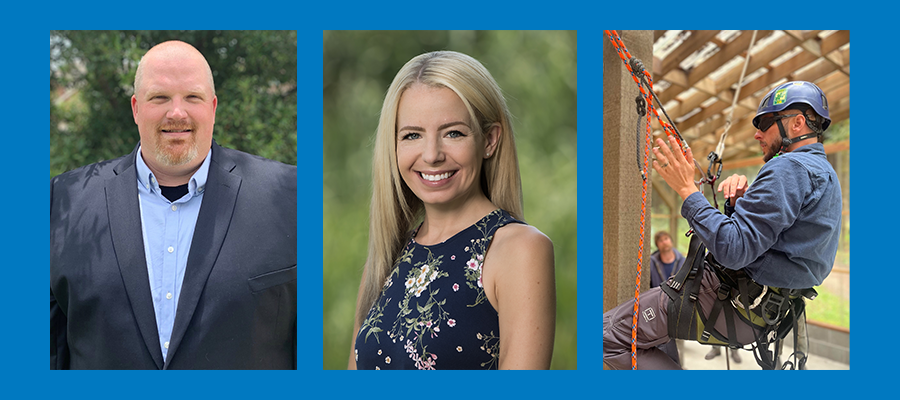- Vegetation Management Services
- Industries
- In Your Neighborhood
- About
- Careers
- Webinars
- Articles
Learning to Learn: How You Can Help the Different Generations of Your Business Succeed

By Kevin Jones, ACRT and Keith Pancake, ACRT and Bermex
How many generations can you name right now? You’d probably be able to name a few, particularly those that came before and after your generation. You might even be able to name all six that are still living in America today. Some are still growing into adulthood, while others are living out their golden years. But what’s more challenging than naming the generations is understanding the key differences between them.
A lot is already common knowledge when it comes to generational differences: Baby Boomers that are entering retirement are impacting the economy. The individualism of Generation X contrasts with the team-minded nature of Millennials. Millennials grew up using digital channels to learn and interact, which is shadowed only by Generation Y using technology from a much earlier age.
Despite what we already know about the living generations, there are far more differences in how they enter the workforce and learn and use skills. And because a person’s age cannot legally be considered in a hiring decision, generational differences often don’t factor into training programs for employees. However, it’s not a matter of determining age, but a matter of understanding how people learn so they can be successful in their jobs.
This is critical in the utility services industry, where training — particularly in workplace safety — is paramount to the success of individuals, the utility or services company they work for, and that company’s customers. What your employees know or don’t know has a far-reaching effect, so helping them learn in a way they’re familiar with and responsive to translates into success (and safety) for everyone involved.
Let’s take a look at how three major working generations learn (and how to prepare for the current Gen Z) and what you can do to ensure they’re successful in their roles.
Baby Boomers (1946–1964)
As Baby Boomers learned in a structured, linear fashion, those that remain in the workforce and are required to undergo continuing education or gain field experience will be best served through classroom and workshop settings. The technology they grew up with was overhead projectors and film strips with some video. This passive learning style was more effective in teacher/student settings. They favor in-class participation, time for reflection, and appreciate getting feedback. They’ll also be more open to reading material.
Boomers represent about 33 percent of today’s workforce. While they’re still actively working, as many as 10,000 are expected to retire on average each day until 2020. This generation is exiting the full-time workforce, but with a couple of years to go (or more), the challenge isn’t training Boomers. It’s helping them understand the training needs of later generations, as they (and Generation X) — will be developing or providing the training.
Generation X (1965–1980)
This generation is often the most misunderstood by other generations. Raised by career-driven parents, Xers grew up on their own — resulting in individualistic learners that had barely any interaction with early computers but still had a desire to learn and make a contribution. Whereas Boomers had greater loyalty to organizations and stayed in positions for years (if not their entire careers), Xers had more distrust of the government and of organizations, leading to more frequent career changes and general skepticism.
For organizations training Xers, it’s important to understand that they prefer self-directed educational opportunities that allow them to learn at their own pace — and on their own schedule. Unlike Boomers, Xers didn’t read books cover to cover, instead they utilized group activities and lecture. For organizations, opportunities for Xers to choose their path is critical. Unique training methods will be useful, along with making training available on-demand. Clear paths for growth, mentoring opportunities, and coaching from external sources will also be helpful in moving Xers throughout their careers and roles.
Generation Y/Millennials (1981–1996)
While Xers grew up with parents who were rarely at home, Millennials have grown up with much more present and involved parents. They have more respect for authority. They are also the first to grow up with significant digital opportunity — computers becoming common household items and the rise of mobile devices both gave way to immediate access to information and a shift in interaction from personal to personal-via-digital.
Whereas earlier generations lived to work, Millennials require more guidance and praise from superiors and educators. They enjoy working in teams, but also need flexibility in their learning approach. Learning should be available on-demand yet kept short and digestible. More importantly, learning should provide a purpose as well as opportunities for improvement. As Millennials are more interactive than previous generations, videos and scenario-style learning will be helpful.
Generation Z/iGen (1997–Present)
This generation has just started entering the workforce. With the oldest among them in their early 20s, many are still in college, but those that graduated early or started early careers are still building the foundation of their experience. This presents an opportunity for organizations to fine-tune their training methods for Gen Z professionals, who will soon be applying for their positions.
Moreso than the on-demand learning needs of Xers and Millennials, the iGen will expect and benefit from flexible learning opportunities over a wide variety of technology, with mobile taking the lead. They will be fast-movers and will thrive in fast-paced environments. Training should make use of various forms of media, with imagery making a fast impact that engages learners. While much will be digital and individual, collaboration and connections between people should be encouraged.
Bridging the Gaps Between Generations
For organizations with multiple generations of workers, it’s important to develop training methods suited to the different learning styles of each generation. Earlier generations preferred an individualized approach, with guided instruction from an educator and opportunities to read and learn separately. Later generations focused on group learning and activities, while current generations are trending toward self-learning outside of the classroom and in a digital space.
Despite this, the human connection remains. Millennials enjoy working and learning in teams though digital learning abounds, and while the iGen is expected to focus more on quick-hit digital channels for learning, many of the platforms they use now focus on collaboration between people.
With one generation transitioning out of the workforce, three active generations spanning a range of learning and workplace preferences, and one generation stepping into place, it has never been more critical for businesses in our industry to take a hard look at how we’re providing learning opportunities. In all, learning styles can be boiled down to three types:
- Individual — standard classrooms, reading materials, individual exercises
- Collaborative — workshops, group activities, interactive projects
- Digital — eLearning, online workshops and courses, video, mobile apps
While just three are listed, the amount of work required for training, safety, and other educational departments to satisfy them would be tremendous. That’s why it’s important to consider the generational makeup of your teams, departments, divisions, and organization as a whole. This may be as simple as running a report through your human resources department to identify the most prevalent generations in your business. Or, consider the use of an organizational survey to identify preferred learning opportunities.
Whatever method you use to identify the generations, look for the common ground between them. Remember, we all use digital channels for various reasons nowadays. Xers, Millennials, and the iGen are all digitally connected outside of the workplace. But what about learning through collaboration? Xers and Millennials are open to it, and with the iGen just now coming into the picture, using collaborative learning from the start can help to establish collaboration as a learning mechanism for the future.
Individual learning should be utilized across the board. After all, we can’t accomplish everything together at once. Courses and videos can be digested individually, with deeper learning and “sinking in” occurring through collaboration. And it all can be done digitally, providing learners that need flexibility or remote access an opportunity to keep up.
Remember, generations will change, and your organization will change with them. Make sure you’re adapting your learning opportunities to give current generations what they need to succeed — and to lay the educational foundation for the generations to come.
Kevin Jones is a business development manager with ACRT. With more than 10 years of experience, he has played a significant role in the growth of ACRT and has helped shape the industry. Kevin holds a Bachelor of Science in Horticulture from The Ohio State University.
Keith Pancake is the safety manager of both ACRT and Bermex. Keith Pancake has been involved in the utility vegetation management industry for 10 years, serving in a variety of field, operational, and auditing roles. He is an ISA Certified Arborist and Utility Specialist with a Bachelor of Arts in Geography/GIS from Keene State College and a Bachelor of Science in Wildlife, Fish and Wildlands Science and Management from Tennessee Technological University.
Related Articles

Servant Leadership in Utility Vegetation Management By C. Troy Ross, President, ACRT and ACRT Pacific On a chilly Monday morning, a utility vegetation management crew gathers for their weekly briefing. Instead of launching into instructions, their supervisor begins by asking each team member how they’re doing. One mentions a child’s illness, another shares excitement about[...]
Read More
Turning Vegetation Waste into Opportunity By Aana Agrawal, Sustainability and Resilience Manager, EnviroScience The utility vegetation management (UVM) sector plays a crucial role in ensuring the smooth transmission of power across regions and cities by keeping plant growth under control within the vicinity of transmission and distribution lines. However, unrefined vegetation maintenance practices often focus[...]
Read More
Reflections from Will Nutter Silver Shield Award Recipients By Bob Urban, Senior Manager, ACRT Services In an industry where the stakes are high and every decision can have life-altering consequences, leadership in utility arboriculture isn’t just a managerial function; it’s a calling. Nowhere is this more evident than in the recipients of the Will Nutter[...]
Read More
The Electric Butterfly: Reconnecting with Nature on the Edges By Ryan Meccage, Business Development Manager, ACRT Services In an age dominated by smartphones, constant connectivity, and algorithm-driven content, we’ve never been more digitally immersed. Yet somehow, we’ve also never felt so far removed from the natural world beneath our feet. The urge to step away[...]
Read MoreRecent Posts
- Alex Fields Awarded ACRT Safety Challenge Coin 20th Nov 2025
- Servant Leadership in Utility Vegetation Management 12th Nov 2025
- ACRT Honors Our Veterans 10th Nov 2025
- Anna Davis Awarded Safety Challenge Coin 04th Nov 2025
- ACRT Senior Consulting Utility Forester Recognized as Safety Superstar 15th Oct 2025
Categories
The Leader In Vegetation Management
We are all about people, and we put safety first. Ready to work with our well-trained team?